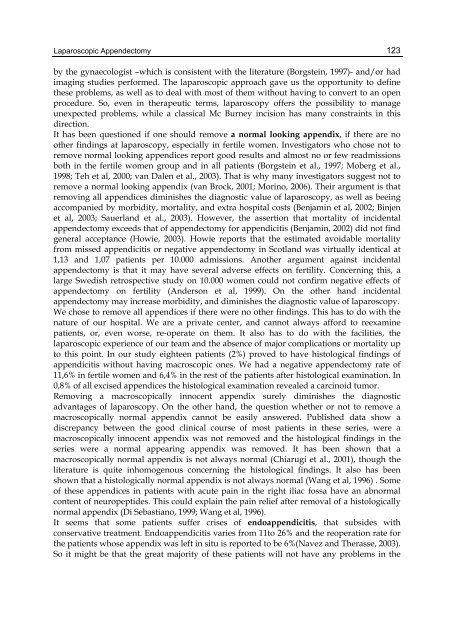UPDATED TOPICS IN MINIMALLY INVASIVE ABDOMINAL SURGERY
UPDATED TOPICS IN MINIMALLY INVASIVE ABDOMINAL SURGERY
UPDATED TOPICS IN MINIMALLY INVASIVE ABDOMINAL SURGERY
You also want an ePaper? Increase the reach of your titles
YUMPU automatically turns print PDFs into web optimized ePapers that Google loves.
Laparoscopic Appendectomy<br />
by the gynaecologist –which is consistent with the literature (Borgstein, 1997)- and/or had<br />
imaging studies performed. The laparoscopic approach gave us the opportunity to define<br />
these problems, as well as to deal with most of them without having to convert to an open<br />
procedure. So, even in therapeutic terms, laparoscopy offers the possibility to manage<br />
unexpected problems, while a classical Mc Burney incision has many constraints in this<br />
direction.<br />
It has been questioned if one should remove a normal looking appendix, if there are no<br />
other findings at laparoscopy, especially in fertile women. Investigators who chose not to<br />
remove normal looking appendices report good results and almost no or few readmissions<br />
both in the fertile women group and in all patients (Borgstein et al., 1997; Moberg et al.,<br />
1998; Teh et al, 2000; van Dalen et al., 2003). That is why many investigators suggest not to<br />
remove a normal looking appendix (van Brock, 2001; Morino, 2006). Their argument is that<br />
removing all appendices diminishes the diagnostic value of laparoscopy, as well as beeing<br />
accompanied by morbidity, mortality, and extra hospital costs (Benjamin et al, 2002; Binjen<br />
et al, 2003; Sauerland et al., 2003). However, the assertion that mortality of incidental<br />
appendectomy exceeds that of appendectomy for appendicitis (Benjamin, 2002) did not find<br />
general acceptance (Howie, 2003). Howie reports that the estimated avoidable mortality<br />
from missed appendicitis or negative appendectomy in Scotland was virtually identical at<br />
1,13 and 1,07 patients per 10.000 admissions. Another argument against incidental<br />
appendectomy is that it may have several adverse effects on fertility. Concerning this, a<br />
large Swedish retrospective study on 10.000 women could not confirm negative effects of<br />
appendectomy on fertility (Anderson et al, 1999). On the other hand incidental<br />
appendectomy may increase morbidity, and diminishes the diagnostic value of laparoscopy.<br />
We chose to remove all appendices if there were no other findings. This has to do with the<br />
nature of our hospital. We are a private center, and cannot always afford to reexamine<br />
patients, or, even worse, re-operate on them. It also has to do with the facilities, the<br />
laparoscopic experience of our team and the absence of major complications or mortality up<br />
to this point. In our study eighteen patients (2%) proved to have histological findings of<br />
appendicitis without having macroscopic ones. We had a negative appendectomy rate of<br />
11,6% in fertile women and 6,4% in the rest of the patients after histological examination. In<br />
0,8% of all excised appendices the histological examination revealed a carcinoid tumor.<br />
Removing a macroscopically innocent appendix surely diminishes the diagnostic<br />
advantages of laparoscopy. On the other hand, the question whether or not to remove a<br />
macroscopically normal appendix cannot be easily answered. Published data show a<br />
discrepancy between the good clinical course of most patients in these series, were a<br />
macroscopically innocent appendix was not removed and the histological findings in the<br />
series were a normal appearing appendix was removed. It has been shown that a<br />
macroscopically normal appendix is not always normal (Chiarugi et al., 2001), though the<br />
literature is quite inhomogenous concerning the histological findings. It also has been<br />
shown that a histologically normal appendix is not always normal (Wang et al, 1996) . Some<br />
of these appendices in patients with acute pain in the right iliac fossa have an abnormal<br />
content of neuropeptides. This could explain the pain relief after removal of a histologically<br />
normal appendix (Di Sebastiano, 1999; Wang et al, 1996).<br />
It seems that some patients suffer crises of endoappendicitis, that subsides with<br />
conservative treatment. Endoappendicitis varies from 11to 26% and the reoperation rate for<br />
the patients whose appendix was left in situ is reported to be 6%(Navez and Therasse, 2003).<br />
So it might be that the great majority of these patients will not have any problems in the<br />
123














![focuspdca.ppt [Compatibility Mode]](https://img.yumpu.com/22859457/1/190x146/focuspdcappt-compatibility-mode.jpg?quality=85)


